Discover The Art Engager
The Art Engager

The Art Engager
Author: Claire Bown
Subscribed: 41Played: 713Subscribe
Share
© Copyright 2025 Claire Bown
Description
The Art Engager Podcast with Claire Bown is your go-to resource for creating engaging experiences in museums and cultural spaces. Explore practices that deepen connections with art, objects, people and ideas. Learn techniques to spark curiosity, foster dialogue, and transform how you engage with your audience. Each episode offers practical insights to enhance your skills and bring your museum experiences to life.
161 Episodes
Reverse
In this episode, host Claire Bown is joined by Menka Sanghvi, researcher, writer, guide and founder of Just Looking. Menka’s work explores attention through science, culture and creativity, and encourages us to slow down and notice more in our everyday lives.Together, we talk about why ordinary moments matter, how our attentional filters shape what we see and the social dimension of noticing. We also explore the pull of digital technology, the difference between algorithmic seeing and intentional looking, and how small shifts can help us reclaim our attention.Whether you work with visitors in museums, guide groups through artworks or simply want to nurture a more spacious way of looking, this conversation offers practical ideas you can apply directly to your facilitation practice (and to your life!).The Art Engager is written and presented by Claire Bown. Editing is by Matt Jacobs and Claire Bown. Music by Richard Bown. Support on PatreonEpisode LinksMenka is the founder of Just Looking, a global community of people looking at everyday life with slowness and curiosity. She is also the co-author of Your Best Digital Life. Her work invites people to notice more, reflect more and reconnect with both the digital and physical worlds.Just Looking newsletterJust Looking’s Instagram60 Experiments in LookingYour Best Digital LifeMenka Sanghvi’s websiteShow Links✨ If you've enjoyed this episode, please consider supporting The Art Engager on Patreon: https://www.patreon.com/c/TheArtEngagerOr pick up a copy of my book, The Art Engager, for step-by-step guidance on creating meaningful, interactive guided experiences https://www.theartengager.com/Buy it here on Amazon.com: https://tinyurl.com/buytheartengager
In this special episode created in collaboration with NEMO – the Network of European Museum Organisations, I’m sharing voices and ideas from the 2025 NEMO European Museum Conference ‘Who Cares? Museums, Wellbeing and Resilience’ in Horsens, Denmark.Recorded during the conference itself in the unique setting of the FÆNGSLET Prison Museum, this episode features eight speakers from across Europe and beyond. Together, we explore how museums are engaging with wellbeing and care – for their communities, their staff, and the wider world.You’ll hear from museum professionals, researchers and cultural leaders reflecting on what care looks like in practice – from building organisational resilience to creating spaces for recovery, reflection and connection. The episode weaves together their experiences to to show how museums are finding new ways to care for people and communities.In this episodeHow museums are rethinking their roles in wellbeing and resiliencePractical examples of care-centred work in actionThe emotional and organisational challenges of supporting wellbeingThe importance of caring for the people who care for othersFeaturingJulia Pagel (Germany) • Vera Carasso (Netherlands) • Elizabeth Merritt (USA) • Inga Surgunte (Latvia) • Sinéad Rice (Ireland) • Yurii Horpynych (Ukraine) • Roberto Casarotto (Italy) • Dr Nuala Morse (UK)The Art Engager is written and presented by Claire Bown. Editing is by Matt Jacobs and Claire Bown. Music by Richard Bown. Support on PatreonLinksNEMO – Network of European Museum OrganisationsNEMO 2025 Statement on Museums and WellbeingConference webpage with recordings✨ If you've enjoyed this episode, please consider supporting The Art Engager on Patreon: https://www.patreon.com/c/TheArtEngagerOr pick up a copy of my book, The Art Engager, for step-by-step guidance on creating meaningful, interactive guided experiences https://www.theartengager.com/Buy it here on Amazon.com: https://tinyurl.com/buytheartengager
In this episode of The Art Engager, I’m talking with Dr Elizabeth (Zab) Johnson, Executive Director of the Wharton Neuroscience Initiative and a visual neuroscientist whose work explores the intersection of art, perception and leadership.Zab’s research asks one key question: how does what we see guide our decisions, actions and behaviours? Her work combines neuroscience, visual perception and museum-based learning to show how what we see shapes how we think, communicate and lead.At Wharton, Zab leads sessions for business executives that bring slow looking and perspective taking together — helping leaders strengthen empathy and communication through shared experiences of looking at art.We talk about her journey from researching colour and form processing in the brain to designing slow art experiences that build leadership skills. You’ll hear why museums are ideal for practising perspective taking, what happens when groups spend an hour with a single artwork, and how slow looking in dialogue with others fosters deep learning and connection.We also discuss the neuroscience behind these practices, the ‘no pointing’ rule, and why words like ‘obviously’ can shut down conversation. This episode offers plenty to think about for anyone interested in how collective looking can enhance empathy, attention and leadership.The Art Engager is written and presented by Claire Bown. Editing is by Matt Jacobs and Claire Bown. Music by Richard Bown.✨ If you've enjoyed this episode, please consider supporting The Art Engager on Patreon: https://www.patreon.com/c/TheArtEngagerOr pick up a copy of my book, The Art Engager, for step-by-step guidance on creating meaningful, interactive guided experiences https://www.theartengager.com/Buy it here on Amazon.com: https://tinyurl.com/buytheartengagerEpisode Linkshttps://knowledge.wharton.upenn.edu/article/perspective-taking-brain-hack-can-help-make-better-decisions/Visual Marketing: A Practical Guide to the Science of Branding https://www.routledge.com/Visual-Marketing-A-Practical-Guide-to-the-Science-of-Branding--Retailing/Kahn-Johnson/p/book/9781032731322Dr Elizabeth (Zab) Johnson on LinkedIn: https://www.linkedin.com/in/elizabeth-johnson-phd-a3160932/Wharton Neuroscience website:https://neuro.wharton.upenn.edu/
In today's solo episode, host Claire Bown celebrates the one-year anniversary of The Art Engager book with our first-ever Ask Me Anything format. She answers 10 practical questions from listeners about facilitating guided experiences in museums.From how long to let people look at artworks to building psychological safety with established groups, Claire tackles the real challenges educators and guides face every day. Does everyone have to talk to be actively engaged? How do you pull a group back when disengaged? What's a good way to redirect someone who's going on too long? When should you share the artist's perspective if the group's discussion is quite different? Resources mentioned in this episode:Book anniversary quick survey The Art Engager: Reimagining Guided Experiences in Museums (Claire's book)Episode 148: How to create active engagement on guided experiencesEpisode 142: Building Trust and Psychological Safety on guided experiencesThe 10 Questioning Practices (QPs) from The Art EngagerThe Thinking Museum® ApproachThe Art Engager is written and presented by Claire Bown. Editing is by Matt Jacobs and Claire Bown. Music by Richard Bown. Support the show on Patreon.As mentioned in the episode, share what's been most helpful from The Art Engager book and what you'd like to see next: Share your input here. https://clebown.typeform.com/to/l9e6mzN9
In this episode of The Art Engager Claire Bown talks with Tina Demirdjian, a poet and educator who has spent over 30 years transforming how people connect with poetry and visual art.Tina is someone who in her own words 'changes people's minds' about poetry, about themselves and about their capacity for creative expression. Working primarily with second language learners and immigrant communities in Los Angeles she has developed unique approaches that use visual art as a gateway into poetry writing.The conversation explores why museums are 'sacred spaces' that support creativity, practical techniques for facilitating poetry writing in galleries and how to help people overcome their intimidation about writing. Listen to this episode if you want to:Learn practical techniques for poetry programming in museums, including spine poetry and found poetry using curator and wall textsDiscover why the museum environment uniquely supports creative confidence and expressionExplore how visual art can serve as a bridge to poetry for diverse audiencesUnderstand how to help visitors overcome intimidation about poetry and writingThis episode offers practical insights into poetry programming and how to create the 'ease' that helps everyone discover they have at least one powerful poem in them.The Art Engager is written and presented by Claire Bown. Editing is by Matt Jacobs and Claire Bown. Music by Richard Bown. Support the show on Patreon and find more resources at thinkingmuseum.com‘The Art Engager: Reimagining Guided Experiences in Museums‘ is now available worldwide through your favourite online platforms and retailers. Buy it here on Amazon.com: https://tinyurl.com/buytheartengagerThe Art Engager book website: https://www.theartengager.com/Support the show with a simple monthly subscription on Patreon: https://www.patreon.com/c/TheArtEngagerEpisode Links: Art inspires youth poetry at MOCA ARTful Conversations https://www.linkedin.com/in/tina-demirdjian-a102488/https://www.instagram.com/poetinastudio/https://www.poetryconsults.com/museums-libraries
In this episode of The Art Engager, Claire Bown talks with Ciaron Wilkinson, Head of Partnerships and Engagement at Manchester Museum — one of the UK’s largest university museums and recent winner of European Museum of the Year.After a values-led redevelopment, Manchester Museum has reimagined how a museum can engage with its community. Its mission is to be the most caring, imaginative, and inclusive museum people will ever visit - a place where everyone belongs. Ciaron shares how this vision has reshaped the museum’s spaces and ways of working: co-curating the South Asia Gallery with 30 community members over five years, celebrating faith and culture through the Manchester Museum Celebrates series, and opening the Top Floor hub, shared with 25 local organisations dedicated to social justice and climate action.This conversation offers practical insights into co-curation, community engagement, and the values-led decisions behind creating cultural spaces where everyone feels welcome.The Art Engager is written and presented by Claire Bown. Editing is by Matt Jacobs and Claire Bown. Music by Richard Bown. Support the show on Patreon and find more resources at thinkingmuseum.com‘The Art Engager: Reimagining Guided Experiences in Museums‘ is now available worldwide through your favourite online platforms and retailers. Buy it here on Amazon.com: https://tinyurl.com/buytheartengagerThe Art Engager book website: https://www.theartengager.com/Support the show with a simple monthly subscription on Patreon: https://www.patreon.com/c/TheArtEngagerEpisode Links:Manchester Museum website Manchester Museum Instagram Article on European Museum of the Year Article on decolonisationNew York Times article following reopening
In today's solo episode, host Claire Bown shares practical strategies for overcoming the most common fears about inquiry-based teaching in museums. From handling uncertainty and awkward silences to managing participation and time, she guides you through simple, actionable ways to build confidence and make inquiry feel rewarding- for you and your participants.Inquiry-based teaching works. It creates the kind of museum experiences where participants lean in, ask questions, and make personal connections with art and objects. But despite all these benefits, why do many people feel hesitant about giving it a go?We’ll explore common concerns - like losing control, time management, participation, or not having all the answers - and I’ll walk you through strategies to move past them.Here’s what I cover in today’s episode:Why understanding your own relationship with inquiry is the first stepHow to develop comfort with uncertainty and not knowingWhy it helps to start small and build confidence graduallyThe role of flexible structures (like Questioning Practices) in supporting inquiryPractical ways to manage time, participation, and group dynamicsBuilding your facilitation toolkit step by stepWhy practice and reflection are essential for growing your skillsHow to reframe “failure” as a valuable learning opportunityResources mentioned in this episode:The Art Engager: Reimagining Guided Experiences in Museums (my book)Episode 143: Uncertainty: Finding Wonder in Not Knowing with Maggie JacksonEpisode 137: How to Use the UniversalEpisode 142: Building Trust and Psychological Safety on Guided Experiences in MuseumsEpisodes 95 & 96: The Power of Silence in Guided ExperiencesEpisode 66: 7 Ways to Improve Your Active Listening SkillsEvery single episode of The Art Engager podcast webpage: https://thinkingmuseum.com/every-single-episode-of-the-art-engager-podcast/–––✨ If you’ve enjoyed this episode, please consider supporting The Art Engager on Patreon. Or pick up a copy of my book, The Art Engager, for step-by-step guidance on creating meaningful, interactive guided experiences.The Art Engager is written and presented by Claire Bown. Editing is by Matt Jacobs and Claire Bown. Music by Richard Bown. Support the show on Patreon.Show notes‘The Art Engager: Reimagining Guided Experiences in Museums‘ is now available worldwide through your favourite online platforms and retailers. Buy it here on Amazon.com: https://tinyurl.com/buytheartengagerThe Art Engager book website:
In today's solo episode, host Claire Bown explores what wonder is, why museums are perfect spaces for fostering it, and shares eight practical ways to create wonder-filled moments in your guided experiences.How can we reawaken that natural sense of wonder that we had as children? What happens when we intentionally create space for amazement and discovery in our museum experiences?In this episode, we're exploring wonder as a fundamental human capacity. Claire distinguishes wonder from awe and curiosity, introduces different types of wonder we might find in the museum from intellectual and sensory to historical and reflective—and examines why adults often lose their capacity for wonder.Claire shares eight practical strategies for inviting wonder into guided experiences and reminds us that wonder is about slowing down, opening up, and helping participants surprise themselves as they see things anew. The Art Engager is written and presented by Claire Bown. Editing is by Matt Jacobs and Claire Bown. Music by Richard Bown. Support the show on Patreon.Show notes‘The Art Engager: Reimagining Guided Experiences in Museums‘ is now available worldwide through your favourite online platforms and retailers. Buy it here on Amazon.com: https://tinyurl.com/buytheartengagerThe Art Engager book website: https://www.theartengager.com/Support the show with a simple monthly subscription on Patreon: https://www.patreon.com/c/TheArtEngagerEvery single episode of The Art Engager podcast webpage: https://thinkingmuseum.com/every-single-episode-of-the-art-engager-podcast/Episode 150 - How to Create Meaningful Museum Engagement: 10 Best Practices from 150 EpisodesEpisode 151 - The Complete Guide to Slow LookingEpisode 32 - 6 Ways to Create Awe-Inspiring Experiences with Art and ObjectsEpisode 38 3 Key Ways to Foster Curiosity in your Programmes Episode 39 - How to stay curious in your practiceEpisodes 95 -...
Over the past four years, we've explored slow looking in 20 different episodes on The Art Engager, making it our most discussed topic. Today, I'm taking you on a curated journey through all of these episodes, creating a roadmap, if you will, that you can use to understand and implement slow looking in your personal practice and professional work. The Art Engager is written and presented by Claire Bown. Editing is by Matt Jacobs and Claire Bown. Music by Richard Bown. Support the show on Patreon.SHOWNOTESEvery single episode of The Art Engager podcast webpage: https://thinkingmuseum.com/every-single-episode-of-the-art-engager-podcast/‘The Art Engager: Reimagining Guided Experiences in Museums‘ is now available worldwide through your favourite online platforms and retailers. Buy it here on Amazon.com: https://tinyurl.com/buytheartengagerThe Art Engager book website: https://www.theartengager.com/**Support the show with a simple monthly subscription on Patreon: https://www.patreon.com/c/TheArtEngager**Make a one-off donation: https://buymeacoffee.com/clairebownAll of the mentioned episodes:
After 150 episodes exploring engagement in museums and cultural organisations – including 101 solo episodes and 49 guest conversations – host Claire Bown shares 10 of the most powerful insights that have emerged over four years of thinking deeply about engagement principles and practices.For this milestone episode, Claire revisited the entire back catalogue, re-listening to past episodes and looking for patterns. What she found were 10 essential insights about engagement that can shift how we think, plan, and work in museums today.What comes through again and again is the power of simple, intentional adjustments. These are practical strategies you can try out straight away.Four years and 150 episodes of exploring what really works in museum engagement – distilled into 10 essential principles for anyone working in museum and heritage education.The Art Engager is written and presented by Claire Bown. Editing is by Matt Jacobs and Claire Bown. Music by Richard Bown. Support the show on Patreon.SHOWNOTESSupport the show with a simple monthly subscription on Patreon: https://www.patreon.com/c/TheArtEngagerEvery single episode of The Art Engager podcast webpage: https://thinkingmuseum.com/every-single-episode-of-the-art-engager-podcast/‘The Art Engager: Reimagining Guided Experiences in Museums‘ is now available worldwide through your favourite online platforms and retailers. Buy it here on Amazon.com: https://tinyurl.com/buytheartengagerThe Art Engager book website: https://www.theartengager.com/Make a one-off donation: https://buymeacoffee.com/clairebownAll of the mentioned episodes:149 Art, Play and Joy at Compton Verney with Geraldine Collinge144 6 ways to create powerful connections in museum experiences137 How to use The Universal Questioning Practice136 What are Questioning Practices?131 Stimulating...
In this episode host Claire Bown talks with Geraldine Collinge, Chief Executive at Compton Verney, about their bold approach to creating genuinely engaging cultural spaces through play, accessibility and joy.Geraldine shares how this unique 'art space in a park' in Warwickshire brings together a historic Robert Adam mansion, 120 acres of Capability Brown landscape, and six distinctive collections ranging from Chinese bronzes to British folk art. She explains how Compton Verney's core values - particularly their inclusion of 'fun' - guide everything from exhibition design to community engagement initiatives.Listen to discover their multisensory approach to gallery spaces that incorporates touch, smell and sound, doubling visitor numbers to their Naples collection. Learn about their 'play first' philosophy that encourages visitors of all ages to engage meaningfully with art through creative exploration, and hear about their 97% discounted community passes that are breaking down barriers to access. Geraldine also shares insights into how they're connecting art and nature through immersive experiences like 'Breathing with the Forest,' creating what she describes as a restorative experience that ultimately delivers on their promise: giving visitors 'a day full of joy.'The Art Engager is written and presented by Claire Bown. Editing is by Matt Jacobs and Claire Bown. Music by Richard Bown. Support the show on Patreon and find more resources at thinkingmuseum.comSHOWNOTES https://www.comptonverney.org.uk/Breathing with the Forest (now closed) - https://www.comptonverney.org.uk/whats-on/breathing-with-the-forest/What we do - https://www.comptonverney.org.uk/our-story/what-we-do/Geraldine Collinge on LinkedIn: https://www.linkedin.com/in/geraldinecollinge/ ‘The Art Engager: Reimagining Guided Experiences in Museums‘ is now available worldwide through your favourite online platforms and retailers. Buy it here on Amazon.com: https://tinyurl.com/buytheartengagerThe Art Engager book website: https://www.theartengager.com/Support the show with a simple monthly subscription on Patreon: https://www.patreon.com/c/TheArtEngager
In this 4th birthday episode of The Art Engager, host Claire Bown explores what active engagement really means and why it matters so much for creating meaningful guided experiences. She addresses what many educators struggle with – we know visitors learn better when actively participating, but how do we consistently make this happen in our daily practice?How can we move beyond knowing that active participation matters to actually implementing it day after day? What practical techniques make the difference between visitors following along and truly engaging?In this episode, Claire explores:Why traditional approaches often lead to disengagement (despite focusing on collection highlights)The spectrum from passive to active The fundamental mindset change required to create active experiencesHow to make your introductions more activeHow to transform questioning from testing knowledge to sparking genuine connection, and meaning-makingWays to use movement and positioning as powerful tools for engagement rather than defaulting to "follow the leader"Simple strategies to move beyond the 'hub and spoke' model and foster direct participant-to-participant interactionHow to share information in a responsive and adaptable way that offers multiple pathways into the core ideas.How to create active closings to help visitors reflect, connect, and carry something forward.The Art Engager is written and presented by Claire Bown. Editing is by Matt Jacobs and Claire Bown. Music by Richard Bown. Support the show on Patreon.Show notes‘The Art Engager: Reimagining Guided Experiences in Museums‘ is now available worldwide through your favourite online platforms and retailers. Buy it here on Amazon.com: https://tinyurl.com/buytheartengagerThe Art Engager book website: https://www.theartengager.com/Support the show with a simple monthly subscription on Patreon: https://www.patreon.com/c/TheArtEngager
In this episode of The Art Engager podcast, host Claire Bown talks with Sita Sargeant, founder and self-described 'Chief Troublemaker' at She Shapes History, a trailblazing Australian company on a mission. What began as weekly walks in Canberra has grown into a thriving social enterprise with nationwide expansion plans for their women-focused history tours.In today's conversation, Sita shares her people-centred approach to guide hiring and training, and how she builds community around a cause rather than just history. She offers valuable insights on designing experiences for specific audiences, creating consistent brand voice across all touchpoints, and using creative approaches such as post-tour feedback surveys to continuously improve quality and support guides.Useful for anyone leading museum tours, developing visitor experiences, or passionate about making history more engaging and accessible. Sita's practical wisdom and enthusiasm will change how you think about connecting audiences with stories that matter. Enjoy!The Art Engager is written and presented by Claire Bown. Editing is by Matt Jacobs and Claire Bown. Music by Richard Bown. Support the show on Patreon.SHOWNOTESSUPPORT THE SHOW with a simple monthly subscription on Patreon: https://www.patreon.com/c/TheArtEngagerShe Shapes History website: https://sheshapeshistory.com.au/She Shapes History Book: https://sheshapeshistory.com.au/she-shapes-history-guided-walks-and-stories-about-great-australian-women/Instagram She Shapes History: https://www.instagram.com/sheshapeshistory/Sita Sargeant LinkedIn profile: https://www.linkedin.com/in/sita-sargeant/‘The Art Engager: Reimagining Guided Experiences in Museums‘ is now available worldwide through your favourite online platforms and retailers. Buy it here on Amazon.com: https://tinyurl.com/buytheartengagerThe Art Engager book website: https://www.theartengager.com/
In this episode, host Claire Bown talks with Tonia Dhaese and Armand Storck about the church-based Slow Art Day movement in Antwerp. We explore why churches provide ideal settings for slow looking and how the architecture, lighting, and atmosphere naturally encourage contemplation.For Slow Art Day 2025 (April 5), listeners will learn about events across four Antwerp churches, including St. Paul's exhibition featuring masterpieces by Rubens and Van Dyck displayed at eye level - a rare opportunity to get up close with artworks normally hung four metres high. Tonia and Armand share practical advice for churches interested in joining the movement, emphasising the importance of training guides to facilitate rather than lecture, maintaining flexibility in approaches, and creating inclusive experiences where no prior knowledge is required. Whether you're interested in slow looking techniques or considering how your own church might participate in Slow Art Day, this conversation offers lots of new insights into creating meaningful art experiences in sacred spaces.The Art Engager is written and presented by Claire Bown. Editing is by Matt Jacobs and Claire Bown. Music by Richard Bown. Support the show on Patreon and find more resources at thinkingmuseum.comSHOWNOTESSUPPORT THE SHOW with a simple monthly subscription on Patreon: https://www.patreon.com/c/TheArtEngagerMKA website: https://mkantwerpen.be/St Paul's Church (Sint Paulus Kerk) Antwerp: https://www.sintpaulusantwerpen.be/en/Tonia Dhaese, Coordinator of Monumental Churches Antwerp (MKA), Tonia.Dhaese@antwerpen.beAntwerp’s Church-Based Slow Art Day Movement - https://www.slowartday.com/antwerps-church-based-slow-art-day-movement/‘The Art Engager: Reimagining Guided Experiences in Museums‘ is now available worldwide through your favourite online platforms and retailers. Buy it here on Amazon.com: https://tinyurl.com/buytheartengagerThe Art Engager book website: https://www.theartengager.com/
In this episode host Claire Bown talks with Francine Boon, a self-described 'sociologist turned mystery maker' and co-director of Sherlocked, an award-winning experience design studio based in Amsterdam, about transforming how visitors engage with museums through immersive storytelling and game design.Francine shares two major museum projects in this episode: her Rijksmuseum escape room that attracted 10,000 participants in nine weeks and received a 9.4/10 rating, and her recent Palace Mysteries project at the Amsterdam Royal Palace. Both demonstrate Francine's ability to reach difficult age demographics (12-18 and 10-12 year olds) through carefully designed puzzles and storytelling that connect visitors with museum collections.Listen to discover practical solutions for designing games in museum spaces, from protecting valuable objects to managing visitor flow. Learn how giving players specific roles encourages appropriate behaviour, explore techniques for building compelling narratives around objects, and find out how to ensure visitors engage meaningfully with collections rather than just playing games.The Art Engager is written and presented by Claire Bown. Editing is by Matt Jacobs and Claire Bown. Music by Richard Bown. Support the show on Patreon and find more resources at thinkingmuseum.comSHOWNOTESTorrentius painting mentioned in this episode: https://www.rijksmuseum.nl/en/collection/object/Emblematic-Still-Life-with-Flagon-Glass-Jug-and-Bridle--9d74acc82f2cd8aa34b03be8414de0cfMuseumNext article: https://www.museumnext.com/article/unlocking-curiosity-transforming-the-rijksmuseum-with-an-escape-room-experience/Linkedin: www.linkedin.com/in/francineboonwebsite: www.sherlocked.nl Instagram: https://www.instagram.com/sherlocked/Form to collaborate: www.sherlocked.nl/museums ‘The Art Engager: Reimagining Guided Experiences in Museums‘ is now available worldwide through your favourite online platforms and retailers. Buy it here on Amazon.com: https://tinyurl.com/buytheartengagerThe Art Engager book website: https://www.theartengager.com/Support the show with a simple monthly subscription on Patreon: https://www.patreon.com/c/TheArtEngager
In today's solo episode, host Claire Bown explores why museums are as much about people as they are about objects, and shares six powerful ways to create meaningful connections in your guided experiences.How can museums provide spaces for genuine human interaction in our increasingly disconnected world? What might happen when we put 'connection before content' in our museum practice? In this episode, we're exploring the unique role museums play in bringing people together. Claire introduces the principle of 'connection before content' and explores the 5 layers of connection that create the conditions for engagement to flourish. Claire shares six essential strategies for creating powerful connections in guided experiences and reminds us that while visitors may forget the facts and figures, they'll remember how they felt and the connections they made.The Art Engager is written and presented by Claire Bown. Editing is by Matt Jacobs and Claire Bown. Music by Richard Bown. Support the show on Patreon.Show notesWhen You Connect, You Protect: The Impact of Social Connection on Mental Health, Ep. 172An interview with Jessica Gifford, LICSW, explaining the link between social connectedness and mental health.https://itunes.apple.com/WebObjects/MZStore.woa/wa/viewPodcast?id=1437668161&i=1000604514535‘The Art Engager: Reimagining Guided Experiences in Museums‘ is now available worldwide through your favourite online platforms and retailers. Buy it here on Amazon.com: https://tinyurl.com/buytheartengagerThe Art Engager book website: https://www.theartengager.com/Support the show with a simple monthly subscription on Patreon: https://www.patreon.com/c/TheArtEngager
In this episode host Claire Bown talks with Maggie Jackson, an award-winning author, former Boston Globe columnist and independent scholar, about the power of uncertainty and how embracing not-knowing might transform our work in museums.Maggie Jackson's latest book "Uncertain: The Wisdom and Wonder of Being Unsure" has been making waves - named on four top books of 2024 lists and recently awarded Nonfiction Book of the Year by the Independent Publishers of New England. Drawing from cutting-edge neuroscience research, Jackson explores how uncertainty affects how we think, learn, and work together.Listen to discover what her research might mean for museum educators and how understanding uncertainty better could transform our practice. Learn about to build your 'uncertainty tolerance', how hedge words like "maybe" can create space for multiple perspectives and interpretations, explore why productive disagreement leads to better group outcomes, and discover the difference between routine and adaptive expertise.This episode will change how you think about uncertainty. Discover how embracing not-knowing can enhance attention, deepen learning and create more meaningful connections with art and visitors alike.Want to learn more? Visit maggie-jackson.comThe Art Engager is written and presented by Claire Bown. Editing is by Matt Jacobs and Claire Bown. Music by Richard Bown. Support the show on Patreon and find more resources at thinkingmuseum.comSHOW NOTESUncertain: The Wisdom and Wonder of Being Unsure is available nowwebsite -- https://www.maggie-jackson.com/uncertainNew York Times op-ed on uncertainty and resilience: https://www.maggie-jackson.com/the-gift-of-being-unsure-what-to-do-1Maggie Jackson on LinkedIn -- https://www.linkedin.com/in/maggiejackson/‘The Art Engager: Reimagining Guided Experiences in Museums‘ is now available worldwide through your favourite online platforms and retailers. Buy it here on Amazon.com: https://tinyurl.com/buytheartengagerThe Art Engager book website: https://www.theartengager.com/Support the show with a simple monthly subscription on Patreon: https://www.patreon.com/c/TheArtEngager
In today's solo episode, host Claire Bown discusses the importance of trust and psychological safety in guided museum experiences.In this episode, we're looking at how to create the conditions that allow people to really engage with art and objects. We're going to explore why trust matters in museum facilitation, what psychological safety looks like in practice, and how to create environments where people feel able to share, question, and discover.The Art Engager is written and presented by Claire Bown. Editing is by Matt Jacobs and Claire Bown. Music by Richard Bown. Support the show on Patreon.Links‘The Art Engager: Reimagining Guided Experiences in Museums‘ is now available worldwide through your favourite online platforms and retailers. Buy it here on Amazon.com: https://tinyurl.com/buytheartengagerThe Art Engager book website: https://www.theartengager.com/Support the show with a simple monthly subscription on Patreon: https://www.patreon.com/c/TheArtEngager
In this episode host Claire Bown talks with Nicole Cromartie, Director of Learning and Engagement, and Paris Baker, Family, Early Childhood and Community Engagement Manager at the Clyfford Still Museum in Denver.Inspired by Nicole's experience with her baby niece 13 years ago, the Clyfford Still Museum has pioneered innovative ways to engage infants with art, including their groundbreaking 2022 exhibition 'Clyfford Still Art and the Young Mind' and Art Crawl, a monthly programme for infants and caregivers to explore art together through multi-sensory experiences.Listen in as Nicole and Paris share insights about their Reggio Emilia-inspired approach, the impact on families and caregivers, and how the program is now expanding beyond museum walls into community spaces. Learn about their successful strategies for creating welcoming environments for the youngest visitors, from professional development across departments to thoughtful program design.If you're interested in early childhood engagement in museums, creating inclusive spaces for young families, or exploring innovative approaches to art education, this episode offers valuable insights and practical recommendations for implementing similar programs.Want to learn more? Visit clyffordstillmuseum.org or email learning@clyffordstillmuseum.orgThe Art Engager is written and presented by Claire Bown. Editing is by Matt Jacobs and Claire Bown. Music by Richard Bown. Support the show on Patreon.Episode LinksInstagram: @still_museumEmail: learning@clyffordstillmuseum.orgCSM's website and Art Crawl's pageAAM article Here are some of the videos that we referenced in our conversationArt Crawl videoArt Crawl "Know Before You Go" video Infant Curation videoNew York Times article featuring Art Crawl https://www.linkedin.com/in/nicole-cromartie-31b19024/https://www.linkedin.com/in/paris-baker-74b71620a/Links‘a...
In this episode host Claire Bown talks with Nicky McIntosh, a museum consultant with over 25 years of experience in the UK museum sector.Inspired by her own family's experiences, Nicky specialises in making museums more accessible for children who struggle to attend school and is currently developing a toolkit to support museums and galleries in their work with home educators.Listen in as Nicky shares insights from her Arts Council funded research exploring how museums can better serve the estimated 1.5 million children in England who face barriers to education, and learn about successful case studies from institutions making their spaces more inclusive.If you're interested in making museums more accessible, supporting diverse learning needs, or exploring ways to engage children facing barriers to education, this episode offers valuable insights and practical recommendations.The Art Engager is written and presented by Claire Bown. Editing is by Matt Jacobs and Claire Bown. Music by Richard Bown. Support the show on Patreon.Episode LinksNicky McIntosh on LinkedIn Website: Museum Learning Works – supporting education outside of school - includes links to the reports and survey results from my Developing Your Creative Practice grant funded by Arts Council EnglandInformation about barriers to school attendance UKNot Fine in School - School Refusal, School AttendanceSquare Peg (teamsquarepeg.co.uk)Recommended Publications‘Can't Not Won't: A Story About A Child Who Couldn't Go To School’ by Eliza Fricker‘A Different Way to Learn: Neurodiversity and Self-Directed Education’ by Dr Naomi Fisher‘Square Pegs: Inclusivity, compassion and fitting in – a guide for schools’ by EllieCostello & Fran MorganLinks'The Art Engager: Reimagining Guided Experiences in Museums' is now available worldwide through your favourite online platforms and retailers. Buy it here on Amazon.com: https://tinyurl.com/buytheartengagerThe Art Engager book website: https://www.theartengager.com/Support the show with a simple monthly subscription on Patreon: https://www.patreon.com/c/TheArtEngager


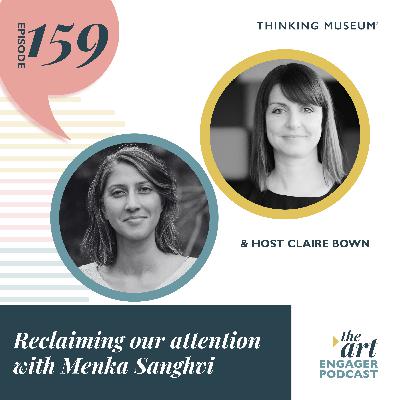
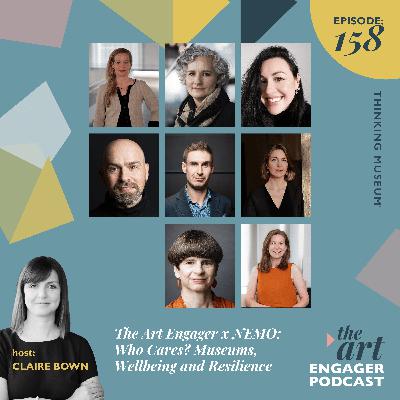


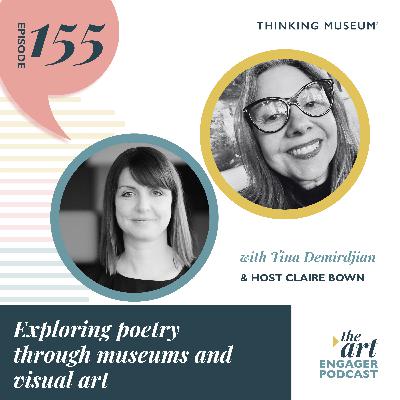
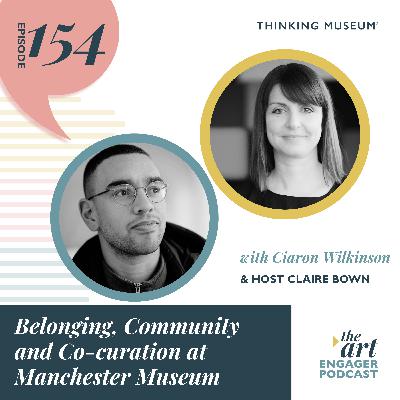
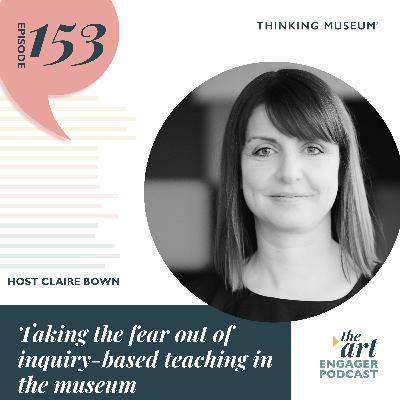
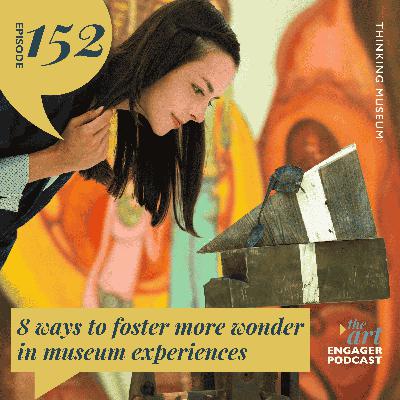
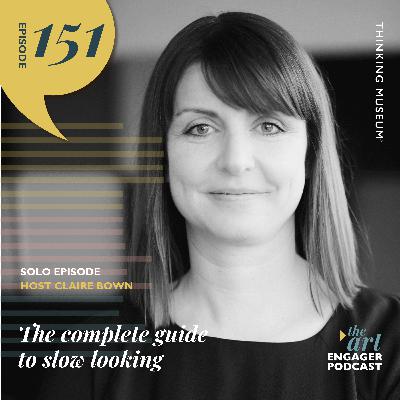
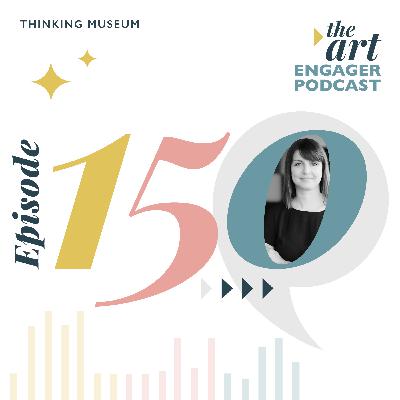
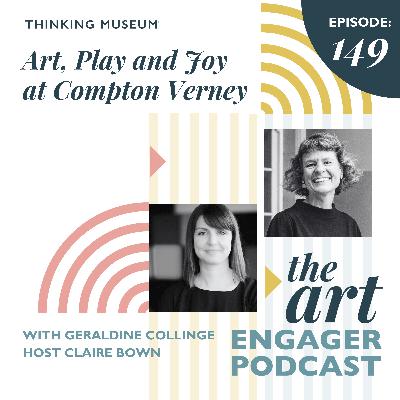

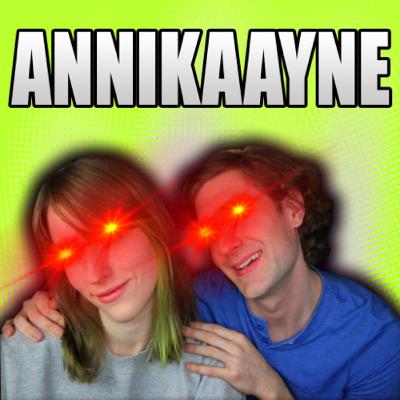



Great discussion! As someone with some background in therapeutic environments, who is now learning about Museums from the inside (I've loved visiting them for MANY years!!) this was really interesting to hear. Such a great concept. Will be listening again and taking notes next time!! Thank you both for sharing this!
Applause to the Art Engager Podcast. If you are a tour director like me, this podcast helps you to connect to your audience using innovative means. Art Engager introduces easy methods to help your audience actually retain and get involved. You will walk away enlightened!